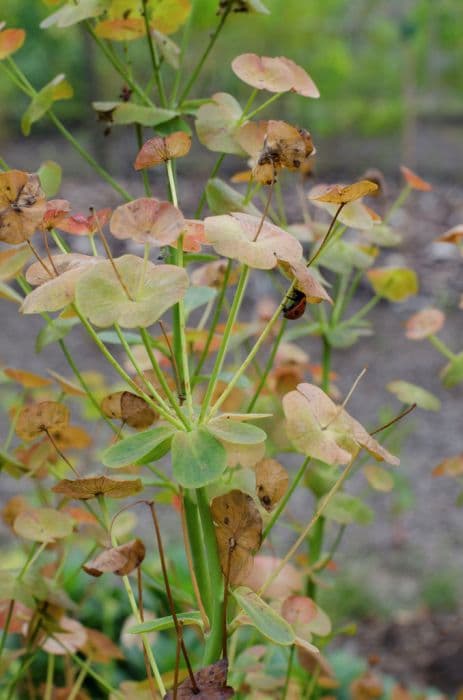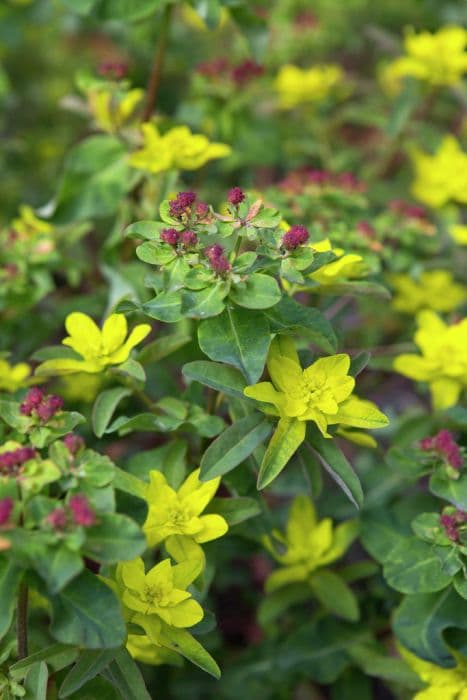Mediterranean Spurge Euphorbia characias 'Glacier Blue' (PBR) (v)

ABOUT
Euphorbia characias 'Glacier Blue' is a striking ornamental plant notable for its distinct foliage and flower spikes. The leaves of this perennial are narrow and oblong, with a beautiful blue-green color that is edged with a creamy-yellow border, giving it a variegated appearance. The colorful contrast of these leaves makes the plant stand out in gardens and landscapes. Come spring, 'Glacier Blue' produces tall, upright flower spikes that boast a dense cluster of tiny flowers. These flowers are an eye-catching lime green to yellow-green hue, and they're neatly packed in cylindrical inflorescences, giving the plant a bristly, architectural look. The combination of the variegated foliage and the vibrant flowers creates a stunning visual display. This variant is also known for its drought tolerance, making it a suitable choice for gardens in dry climates. The structural form and coloration of Euphorbia characias 'Glacier Blue' offer a unique aesthetic appeal to any planting scheme, be it a mixed border or a rock garden.
About this plant
 Names
NamesFamily
Euphorbiaceae
Synonyms
Spurge, Mediterranean Spurge, Glacier Blue Spurge
Common names
Euphorbia characias 'Glacier Blue' (PBR) (v)
 Toxicity
ToxicityTo humans
The Mediterranean spurge (Euphorbia characias 'Glacier Blue' (PBR) (v)) contains a toxic milky latex in its sap that can cause severe irritation to the skin and mucous membranes. If ingested, the plant can induce symptoms such as nausea, vomiting, and diarrhea. Contact with the eyes can result in pain, redness, and blurred vision. Ingestion or contact with the sap should be avoided, and medical attention should be sought if accidental exposure occurs.
To pets
The Mediterranean spurge (Euphorbia characias 'Glacier Blue' (PBR) (v)) is toxic to pets due to its milky latex sap. If pets come into contact with the sap or ingest any part of the plant, they may experience symptoms such as vomiting, diarrhea, drooling, and possible inflammation of the mouth, throat, or stomach. In severe cases, it can lead to more serious symptoms and require veterinary attention. Therefore, it is important to prevent pets from accessing this plant.
 Characteristics
CharacteristicsLife cycle
Perennials
Foliage type
Evergreen
Color of leaves
Variegated
Flower color
Yellow-green
Height
2-3 feet (0.6-0.9 meters)
Spread
2-3 feet (0.6-0.9 meters)
Plant type
Shrub
Hardiness zones
8
Native area
Mediterranean
Benefits
 General Benefits
General Benefits- Ornamental Appeal: Euphorbia characias 'Glacier Blue' adds visual interest to gardens thanks to its unique foliage with blue-green leaves edged in creamy white, and chartreuse flowers.
- Drought Tolerance: Once established, it requires minimal watering, making it suitable for draught-prone areas or water-wise gardens.
- Low Maintenance: This plant is known for being easy to care for, requiring little pruning or additional maintenance, making it ideal for busy gardeners.
- Seasonal Interest: It provides year-round interest with its evergreen foliage and long-lasting spring blooms that add color and texture throughout the seasons.
- Pest Resistance: Generally resistant to pests, reducing the need for chemical treatments and making it a good choice for an eco-friendly garden.
- Versatility: Its striking appearance makes it suitable for a variety of garden styles, including Mediterranean, rock gardens, and coastal landscapes.
- Structural Plant: The strong, vertical growth habit of Euphorbia characias 'Glacier Blue' can add architectural structure to mixed borders or as a standalone feature.
- Attracts Pollinators: The flowers can attract beneficial insects such as bees, which are essential for pollination in the garden.
 Medical Properties
Medical PropertiesThis plant is not used for medical purposes.
 Air-purifying Qualities
Air-purifying QualitiesThis plant is not specifically known for air purifying qualities.
 Other Uses
Other Uses```html
- Textile Dyeing: The milky sap of Spurge may be used as a natural dye for fabrics, imparting a range of yellow to brown hues, depending on the mordant used.
- Photography: In historical photography processes, the sap's unique compounds could potentially assist in the production of certain types of photo-sensitive materials.
- Fish Poison: Historically, some Euphorbia species' sap was used to immobilize fish, making them easier to catch, although this is not an environmentally friendly or legal practice.
- Insect Repellent: The strong odor and toxic sap of Spurge can be used to repel certain insects from gardens or outdoor living areas.
- Latex Substitute: The milky sap could serve as a binding agent or substitute for latex in some natural craft or industrial applications.
- Weather Indicator: Spurge may be observed for certain phenological changes that can help predict weather patterns or seasonal transitions in specific regions.
- Gardening Companion Plant: Spurge could be planted among crops to deter rodents or other pests by capitalizing on its toxic properties.
- Livestock Training: In some traditional farming practices, the plant's irritating sap could be used to create aversion in livestock, keeping them away from certain areas.
- Wood Polish: The sap, once processed and refined, might contribute to natural wood polish formulations to protect and shine wooden surfaces.
- Erosion Control: Spurge could be strategically planted in areas prone to erosion, where its root system can help stabilize soil and prevent degradation.
Interesting Facts
 Feng Shui
Feng ShuiThe Spurge is not used in Feng Shui practice.
 Zodiac Sign Compitability
Zodiac Sign CompitabilityThe Spurge is not used in astrology practice.
 Plant Symbolism
Plant Symbolism- Resilience: Euphorbia characias, commonly known as spurge, often symbolizes resilience and persistence due to its hardy nature and ability to thrive in tough conditions.
- Protection: The milky sap of the spurge is toxic and can cause irritation, leading to its association with protection and the idea of warding off negative influences.
- Purification: Some cultures have viewed the spurge as a means of cleansing and purifying owing to its potent sap, suggesting a symbolic meaning of removing negative energy.
- Healing: Although toxic, the spurge's medicinal properties in small quantities have historically been used to heal ailments, giving it a symbolic connection to healing and medicine.
 Water
WaterThe Mediterranean Spurge, commonly referred to as the Euphorbia characias 'Glacier Blue', should be watered thoroughly but infrequently, making sure the soil is allowed to dry out slightly between waterings. For outdoor plants, water once every 1-2 weeks with approximately 1 gallon of water, and adjust based on rainfall and temperatures. Container-grown specimens may require water once a week, with enough water to see it seeping through the drainage holes, indicating the soil has been saturated evenly. During winter months or cooler weather, reduce watering frequency to prevent overwatering and root rot.
 Light
LightMediterranean Spurge fares best in full sun to partial shade conditions, thriving with at least six hours of direct sunlight daily. The ideal spot for this plant is a south-facing or west-facing location where it can bask in ample brightness while being protected from the intense midday sun in very hot climates. Too little light can lead to leggy growth and diminished foliage color.
 Temperature
TemperatureThe Mediterranean Spurge is adapted to temperatures typical of its native Mediterranean climate, preferring a range between 50°F and 80°F. It can tolerate temperatures down to about 30°F, but frost may damage the foliage. Ideally, maintain an environment where temperatures are consistently above freezing to ensure vigorous growth.
 Pruning
PruningPruning Mediterranean Spurge is essential for maintaining its shape and encouraging healthy growth. Light trimming can be done in late spring or early summer, after the flowering period, to remove spent flowers and shape the plant. Cut back one-third of the plant's height to promote bushier growth and prevent legginess. Pruning is generally recommended annually or as needed to control size.
 Cleaning
CleaningAs needed
 Soil
SoilMediterranean Spurge 'Glacier Blue' prefers well-draining soil with some organic matter and a pH between 6.0 and 7.5. A good mix would be one part sand, one part compost, and one part loam or peat.
 Repotting
RepottingMediterranean Spurge 'Glacier Blue' should be repotted every 2-3 years or when it outgrows its current pot, typically in the spring before new growth starts.
 Humidity & Misting
Humidity & MistingMediterranean Spurge 'Glacier Blue' tolerates a wide range of humidity levels but does best with moderate humidity, avoiding extremely high or low humidity environments.
 Suitable locations
Suitable locationsIndoor
Place in bright light; well-draining soil.
Outdoor
Full sun; well-draining soil; protect from frost.
Hardiness zone
7-10 USDA.
 Life cycle
Life cycleThe Spurge 'Glacier Blue' starts its life as a seed, germinating in warm, well-drained soil typically in spring. After germination, the seedling stage follows, where the initial roots and shoots develop and true leaves emerge. As the seedling matures, it enters the vegetative stage, growing larger and producing the characteristic blue-green foliage with variegated edges and stems. The plant then reaches the flowering stage, typically in early to late spring, displaying its unique structure of small flowers within cupped bracts. After pollination, often by insects, the flowers develop into fruit, which are capsules containing seeds that, when mature, can burst and disperse to start a new cycle. Throughout its life, which can span several years in the right conditions, the Spurge 'Glacier Blue' perennially dies back in the winter and re-emerges from its root system each spring.
 Propogation
PropogationPropogation time
Spring-Early Summer
The Euphorbia 'Glacier Blue' is commonly propagated through cuttings, a process that is preferably carried out during the warmer months of the year, such as late spring or early summer. To propagate by cuttings, a healthy stem is selected and cut just below a node with a sharp, clean cutting tool. The cutting should be about 4 to 6 inches (10 to 15 centimeters) long. Before planting the cutting, the milky sap should be allowed to dry for a few hours to reduce the risk of rot. The end of the cutting is then dipped in rooting hormone powder to encourage root development and planted in a pot filled with a well-draining soil mix. The pot is kept in a warm place with bright, indirect light and the soil is maintained slightly moist until rooting occurs. After a few weeks, when the cutting has established roots, it can be transplanted into a larger pot or directly into the garden.


![Spurge [Silver Swan]](/_next/image?url=https%3A%2F%2Fplants-admin.emdemapps.com%2Fimages%2Fplants%2F%2Fimages%2F604b573f6c8f6.png&w=640&q=75)






